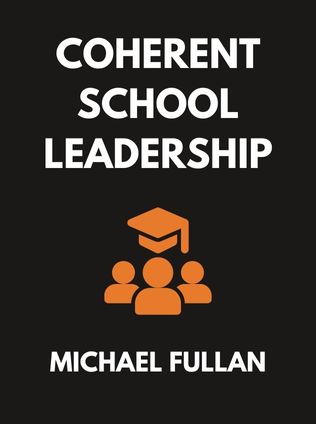
Coherent School Leadership
Forging Clarity from Complexity
By Michael Fullan,
Published 08/2019
Coherent School Leadership: Forging Clarity from Complexity
Authors: Michael Fullan and Lyle Kirtman
About the Authors
Michael Fullan is a renowned authority on educational reform, with a deep commitment to transforming education systems worldwide. He has authored numerous books on the subject, providing invaluable insights and practical frameworks for leaders in education. Fullan's expertise lies in understanding the complex dynamics of school improvement and leadership.
Lyle Kirtman is a leadership expert with extensive experience in developing leadership competencies and frameworks that drive organizational change. He focuses on helping leaders build the skills necessary to navigate the complexities of educational environments. Together with Fullan, Kirtman brings a wealth of knowledge and practical strategies for achieving coherence in school leadership.
Main Idea
"Coherent School Leadership" aims to help educational leaders forge clarity from the inherent complexities within school systems. The book combines Michael Fullan’s Coherence Framework with Lyle Kirtman’s 7 Competencies for Highly Effective Leaders to create a powerful approach for driving coherence. This involves a shared depth of understanding about the work and its impact on student achievement, enabling a proactive culture in schools.
Table of Contents
- Introduction
- The Coherence Framework
- The 7 Competencies for Highly Effective Leaders
- Integrating the Framework and Competencies
- Putting the Coherence Framework into Practice
- Conclusion: Leadership for the Future
Introduction
In "Coherent School Leadership," Fullan and Kirtman set out to demonstrate how proven frameworks and specific competencies can help leaders manage the unpredictable and often disrupted landscape of education. They emphasize the need for grounded frameworks that allow leaders to influence and learn from their ever-changing environments. The book's essence lies in making coherence a continuous process rather than a static goal.
The Coherence Framework
The Coherence Framework consists of four interactive components that are essential for achieving organizational coherence:
- Focusing Direction
- Cultivating Collaborative Cultures
- Deepening Learning
- Securing Accountability
Focusing Direction
The first component, focusing direction, involves creating a purpose-driven mindset, setting impactful goals, developing clear strategies, and exhibiting change leadership. It is about aligning vision and goals with actionable strategies that foster coherence. Leaders must identify strengths within the school and ensure that staff understand and support the direction of the school.
"The key to successful leadership today is influence, not authority." - Michael Fullan
To challenge the status quo effectively, leaders need courage and a steadfast focus on improving student outcomes. This involves building partnerships within the organization and integrating push and pull competencies to drive change.
Cultivating Collaborative Cultures
Cultivating collaborative cultures is crucial for coherence. This component focuses on building a culture of growth, promoting learning leadership, enhancing capacity, and fostering collaborative work. Three competencies are particularly relevant here:
- Builds Trust Through Clear Communications and Expectations: Clear communication and direct feedback help build trust and support high performance.
- Focuses On Team Over Self: Effective teams are essential for collaboration. Leaders must teach the importance of teamwork and trust.
- Creates a Commonly Owned Plan for Success: Involving all stakeholders in planning ensures ownership and support for the plan.
"Trust is the glue of life. It's the most essential ingredient in effective communication. It's the foundational principle that holds all relationships." - Stephen R. Covey
Deepening Learning
Deepening learning is at the heart of successful educational change. This involves setting clear learning goals, employing precise pedagogical methods, and shifting practices through capacity-building. Leaders should build external networks and partnerships to support deep learning.
The opportunity to build networks and partnerships in education is greater today than ever before. Leaders must extend their learning to other schools, districts, and communities, leveraging external expertise and resources to enhance internal capabilities.
"Education is not the filling of a pail, but the lighting of a fire." - William Butler Yeats
Building partnerships with parents is also crucial. Leaders need to adopt best practices to involve parents in the educational process, making them partners in deepening learning.
Securing Accountability
Securing accountability involves balancing internal and external accountability measures. Competency 6, which emphasizes continuous improvement of self and the organization, is vital for this component. Leaders must model a commitment to personal and organizational growth.
Competency 5, which focuses on maintaining a high sense of urgency for change and sustainable results, is also crucial. Leaders must connect reflection with proactive actions to ensure continuous improvement and accountability.
Sign up for FREE and get access to 1,400+ books summaries.
You May Also Like
I Am Malala
The Story of the Girl Who Stood Up for Education and Was Shot by the Taliban
By Malala YousafzaiThe Lean Startup
How Today's Entrepreneurs Use Continuous Innovation to Create Radically Successful Businesses
By Eric RiesWho Moved My Cheese?
An Amazing Way to Deal with Change in Your Work and in Your Life
By Spencer Johnson, M.D.Make Your Bed
Little Things That Can Change Your Life...And Maybe the World
By William H. McRavenThe Ride of a Lifetime
Lessons Learned from 15 Years as CEO of the Walt Disney Company
By Robert IgerThe Hard Thing About Hard Things
Building a Business When There Are No Easy Answers
By Ben Horowitz



















